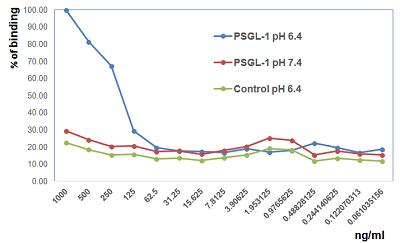PSGL-1 (human):Fc (human) (rec.)
Product Code:
AG-40B-0190
AG-40B-0190
Regulatory Status:
RUO
RUO
Target Species:
Human
Human
Shipping:
Blue Ice
Blue Ice
Storage:
-20°C
-20°C
No additional charges, what you see is what you pay! *
| Code | Size | Price |
|---|
| AG-40B-0190-C050 | 50 ug | £360.00 |
Quantity:
| AG-40B-0190-C500 | 500 ug | £2,610.00 |
Quantity:
Prices exclude any Taxes / VAT
Stay in control of your spending. These prices have no additional charges, not even shipping!
* Rare exceptions are clearly labelled (only 0.14% of items!).
* Rare exceptions are clearly labelled (only 0.14% of items!).
Multibuy discounts available! Contact us to find what you can save.
This product comes from: Switzerland.
Typical lead time: 7-10 working days.
Contact us for more accurate information.
Typical lead time: 7-10 working days.
Contact us for more accurate information.
- Further Information
- Documents
- References
- Show All
Further Information
Alternate Names/Synonyms:
P-selectin Glycoprotein Ligand 1; Selectin P Ligand; CD162; SELPLG
Biological Activity:
Binds to the human protein VISTA at acidic pH 6.4.
Concentration:
1mg/ml after reconstitution.
EClass:
32160000
Endotoxin:
<0.01EU/µg purified protein (LAL test).
Form (Short):
liquid
Formulation:
Lyophilized. Contains PBS.
Handling Advice:
After reconstitution, prepare aliquots and store at -20°C.Avoid freeze/thaw cycles.Centrifuge lyophilized vial before opening and reconstitution.PBS containing at least 0.1% BSA should be used for further dilutions.
Long Description:
Protein. The extracellular domain of human PSGL-1 (aa 42-305) is fused at the C-terminus to the Fc portion of human IgG1. Source: HEK 293 cells. Endotoxin content: <0.01EU/µg purified protein (LAL test). Lyophilized. Contains PBS. Purity: >95% (SDS-PAGE). P-selectin glycoprotein ligand-1 (PSGL-1) is a 120kda transmembrane homodimer protein that is primarily expressed on lymphoid and myeloid cells, including platelets. PSGL-1 was first identified to regulate the rolling/tethering of neutrophils on activated endothelium through P-selectin binding. PSGL-1 binds P-, E- and L- selectin through the N-terminus of the extracellular domain upon special glycosylation (sialyl Lewis x). PSGL-1 functions in regulating the migration of macrophages/monocytes, plasma B cells, dendritic cells and T cells by selectin engagement. PSGL-1 also regulates localization of macrophages, dendritic cells and B cells in the lamina propria at steady state. Although PSGL-1 is expressed on resting T cells, selectin binding capacity is only acquired during the proliferation/differentiation of effector T cells. In addition to its migratory properties, the adhesion protein PSGL-1 also functions in a selectin-independent manner as a negative regulator of T cell responses in contexts of chronic viral infection, cancer and some autoimmune diseases. For this immune checkpoint function, it has recently been reported that PSGL-1 binds the negative immune checkpoint regulator VISTA (V-domain immunoglobulin suppressor of T cell activation). PSGL-1 expressed on leukocytes binds to multimeric VISTA at acidic pH, but not at the physiological pH 7. This acidic influence of the binding is due to multiple histidine residues protonation located in the VISTA extracellular domain. VISTA - PSGL-1 interaction shows that immune response can be regulated by acidic environments found in tumors. Identification of PSGL-1 - VISTA signaling pathways in T cells could lead to new therapeutic targets that increase immune function, such as in chronic viral infections or in cancer, or attenuate immune function such as in autoimmunity.
Molecular Weight:
~95-100kDa (SDS-PAGE)
NCBI, Uniprot Number:
Q14242
Other data:
UniProt link Q14242: PSGL-1 (human) https://www.uniprot.org/uniprot/Q14242
Package Type:
Plastic Vial
Product Description:
P-selectin glycoprotein ligand-1 (PSGL-1) is a 120kda transmembrane homodimer protein that is primarily expressed on lymphoid and myeloid cells, including platelets. PSGL-1 was first identified to regulate the rolling/tethering of neutrophils on activated endothelium through P-selectin binding. PSGL-1 binds P-, E- and L- selectin through the N-terminus of the extracellular domain upon special glycosylation (sialyl Lewis x). PSGL-1 functions in regulating the migration of macrophages/monocytes, plasma B cells, dendritic cells and T cells by selectin engagement. PSGL-1 also regulates localization of macrophages, dendritic cells and B cells in the lamina propria at steady state. Although PSGL-1 is expressed on resting T cells, selectin binding capacity is only acquired during the proliferation/differentiation of effector T cells. In addition to its migratory properties, the adhesion protein PSGL-1 also functions in a selectin-independent manner as a negative regulator of T cell responses in contexts of chronic viral infection, cancer and some autoimmune diseases. For this immune checkpoint function, it has recently been reported that PSGL-1 binds the negative immune checkpoint regulator VISTA (V-domain immunoglobulin suppressor of T cell activation). PSGL-1 expressed on leukocytes binds to multimeric VISTA at acidic pH, but not at the physiological pH 7. This acidic influence of the binding is due to multiple histidine residues protonation located in the VISTA extracellular domain. VISTA - PSGL-1 interaction shows that immune response can be regulated by acidic environments found in tumors. Identification of PSGL-1 - VISTA signaling pathways in T cells could lead to new therapeutic targets that increase immune function, such as in chronic viral infections or in cancer, or attenuate immune function such as in autoimmunity.
Purity:
>95% (SDS-PAGE)
Sequence:
The extracellular domain of human PSGL-1 (aa 42-305) is fused at the C-terminus to the Fc portion of human IgG1.
Source / Host:
HEK 293 cells
TAGs:
Fc
Transportation:
Non-hazardous
UNSPSC Category:
Other Proteins
UNSPSC Number:
12352202
Use & Stability:
Stable for at least 6 months after receipt when stored at -20°C. Working aliquots are stable for up to 3 months when stored at -20°C.
References
VISTA is an acidic pH-selective ligand for PSGL-1: R.J. Johnston, et al.; Nature 574, 565 (2019)



